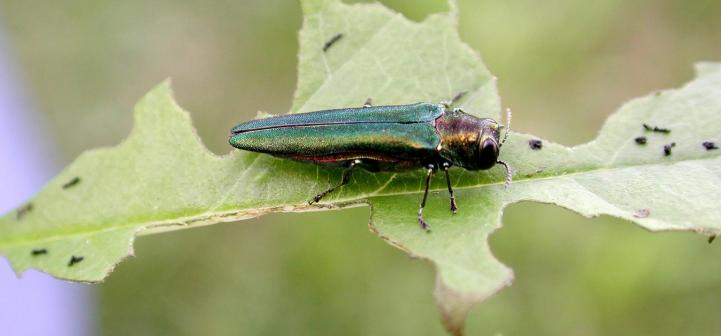Invasive Species: Setaria faberi, Giant Foxtail
Giant foxtail is an invasive annual grass that can reach 2 to 5 ft. (0.61 to 1.5 m) in height. Leaves are up to 16 in. (41 cm) long, 0.6 to 1 in. (15 to 25 mm) wide with small hairs covering the top of the leaves. Flowering occurs in late summer to early fall, when a green (eventually straw-colored), bristly inflorescence develops. The inflorescence resembles a foxtail, hence the common name. The fruit are small flattened ovoids with hard coats. They usually germinate in late spring to early summer. Giant foxtail is native to Asia and was accidentally introduced in the United States in the 1920s as a contaminant of other grain. Plants invade disturbed sites such as roadsides, landfills, fence rows, and right of ways.
What are invasive species and why should we be concerned about them?
Taxonomy: Scientific and Common Names for This Species
Cyperales > Poaceae > Setaria faberi Herrm.
Synonym(s): Japanese bristlegrass, Chinese foxtail, Chinese millet, giant bristlegrass, nodding foxtail
Setaria faberi – USDA PLANTS Profile
Distribution Maps
Giant foxtail – The reported distribution of this invasive species across the United States (Source: Invasive Plant Atlas of the United States)
Up-to-the-minute distribution maps and why they are important
Reporting This Invasive Species
What is the best way and place to report the occurrence of an invasive species?
How to report an invasive species sighting to EDDMapS – Early Detection & Distribution Mapping System
EDDMapS – Report an Invasive Species to EDDMapS.
Cooperative Extension Offices – Find your local Cooperative Extension office on this map provided by USDA.
How to Identify
This invasive species can be identified by looking for the following characteristics described in the paragraphs that follow.
Grass
Giant foxtail is an invasive annual grass that can reach 2 to 5 ft. (0.61 to 1.5 m) in height.
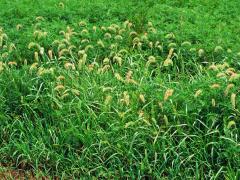 |
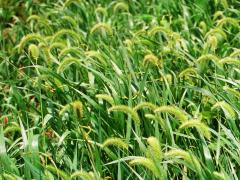 |
| John D. Byrd, Mississippi State University, bugwood.org | John D. Byrd, Mississippi State University, bugwood.org |
Foliage
Leaves are up to 16 in. (41 cm) long, 0.6 to 1 in. (15 to 25 mm) wide with small hairs covering the top of the leaves.
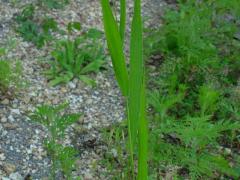 |
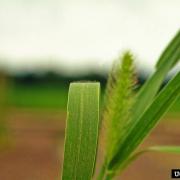 |
| Dan Tenaglia, Missouriplants.com, bugwood.org |
John D. Byrd, Mississippi State University, |
Flower
Flowering occurs in late summer to early fall, when a green (eventually straw-colored), bristly inflorescence develops. The inflorescence resembles a foxtail, hence the common name.
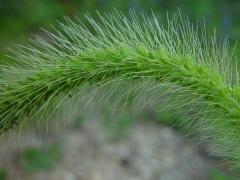 |
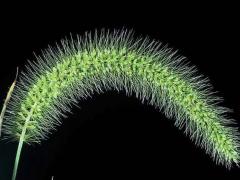 |
| Dan Tenaglia, Missouriplants.com, bugwood.org | Joseph M. DiTomaso, University of California-Davis, bugwood.org |
Fruit
The fruit are small flattened ovoids with hard coats.
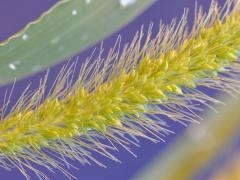 |
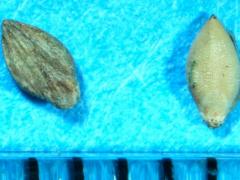 |
| Bruce Ackley, Ohio State University, bugwood.org | Bruce Ackley, Ohio State University, bugwood.org |
Native Species That Can Resemble Giant Foxtail
Digitaria sanguinalis, large crabgrass – Images at Invasive.org
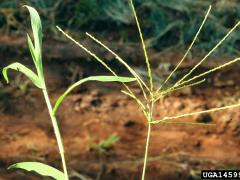 |
 |
| Steve Dewey, Utah State University, bugwood.org |
Joseph M. DiTomaso, University of California – Davis, bugwood.org |
– Images at Invasive.org
| bugwood.org | bugwood.org |
Additional Images for Giant Foxtail
Giant foxtail – Images at Invasive.org
Additional Information, Biology, Control and Management Resources
Control and management recommendations vary according to individual circumstances. Location, habitat, weather, and a variety of other conditions are factors that help determine the best treatment choice. To find the safest and most effective treatment for your situation, consult your state’s land-grant institution. If you will use chemicals as part of the control process, always refer to the product label.
United States Land-Grant University System – Find your land-grant university’s college of agriculture, Cooperative Extension office, or other related partner on this map provided by USDA.
Weed of the Week – USDA Forest Service
Taxon Report 7535 – Calflora
Grasses – Missouriplants.com
Virginia Tech Weed Identification Guide – Virginia Cooperative Extension
Robert W. Freckmann Herbarium – University of Wisconsin-Stevens Point
